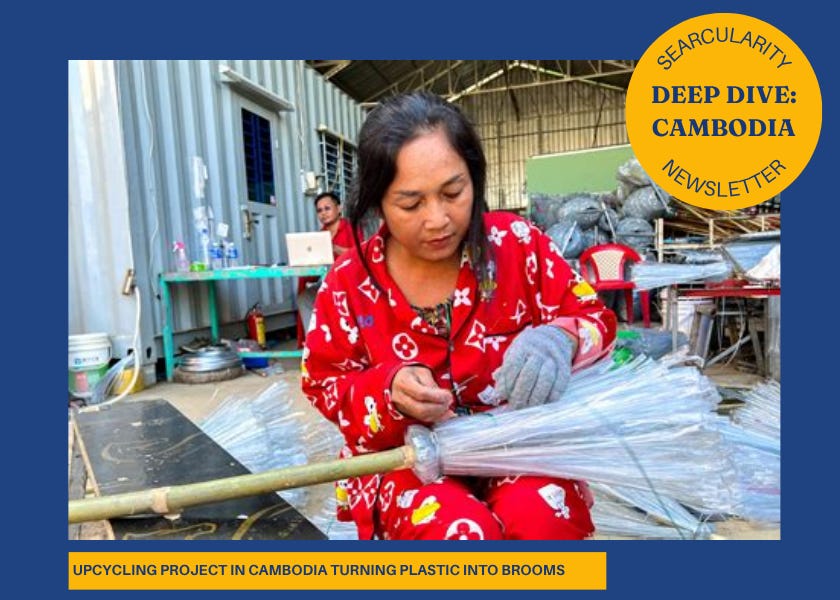Deep dive: Cambodia's circular economy strategy
How the Kingdom of Wonder is rewriting its development playbook

Hey there! Mutiara here and I'm back with another Southeast Asian deep dive.
This time, we're heading to Cambodia. 🇰🇭
After covering the Philippines' progressive waste laws, Cambodia presents us with something completely different: a country that's not pretending to be anyone else.
While richer neighbours drop polished circular economy strategies like they're launching new iPhones, Cambodia is doing the messy, honest work of figuring out how to build sustainable systems when you're still building basic infrastructure.
💡 Interesting take from Cambodia: This is a country where 40.5% of the economy depends on garment manufacturing. Waste pickers are essential infrastructure, and choosing between economic growth and environmental protection is still a common question.
Cambodia's current waste challenges
🗑️ Textile waste mountain: The garment industry generates 140,000 tonnes of textile waste annually. Most get dumped or burned because there's literally nowhere else for it to go.
🏭 It hits GDP hard: 40.5% of Cambodia's economy comes from making clothes for the rest of the world. When people talk about "stepping away from fast fashion," they're talking about restructuring nearly half the national economy.
🚛 Collection gaps: Only 35.7% of urban poor have proper waste collection services. The other 64.3% are making do with whatever they can figure out.
📍 Landfill crisis: 83% of waste ends up in unregulated landfills.
🌾 Opportunity from agriculture: 17% of GDP comes from agriculture, with rice straw upcycling projects showing potential but lacking scale and funding.
♻️ Recycling infrastructure: There is no national recycling network. Full stop. The country runs on informal waste pickers doing essential work without recognition or support.

Scaling up circular economy with National Plans
Every few months, another country announces its circular economy transformation.
Same consultants. Same buzzwords. Same PowerPoint templates.
Cambodia's approach? Refreshingly honest about its priorities.
Cambodia's circular economy framework is anchored by two key policies:
1. 2021 National Circular Economy Strategy
✨ Vision: Transform Cambodia into a circular economy supporting economic prosperity, social equity, and environmental health
🏛️ Core Pillars:
🎯 Key Targets:
Sources: Circular Strategy on Environment, Cambodian Ministry of Environment
2. Circular Strategy on Environment (2023–2028)
✨ Vision: Achieve carbon neutrality and 60% forest cover by 2050 through three transformative angles
♟️ Core Strategy:
🪽 Strategic Evolution (2021 vs 2023)
Sources: Circular Economy Strategy and Action Plan, Cambodian Ministry of Environment
🔍 Progress Snapshot (as of 2025)
EPR Adoption: Major manufacturers now report plastic footprints
Illegal Dumping: Reduction since drone surveillance began
Public Awareness: Urban residents recognise "circular economy" term
Pandemic disruptions: Waste reduction targets are not met due to COVID-19 disruptions
Funding shortfalls: New strategy faces funding shortfalls
Role of activism in the country
Cambodia's environmental movement has real stakes.
👏 The frontline fighters: Mother Nature Cambodia: Youth-led group that's accomplished the impossible—stopping sand exports (2016) and killing a hydroelectric dam (2014). Eleven activists have been jailed since 2015 due to this.
🦸♀️ CSARO: The unsung heroes working since 1997 to turn waste pickers into recycling entrepreneurs. No viral campaign, just practical circular economy solutions.
Success stories worth mentioning

Lim Vanny Plastic Recycle: Processes 100 tonnes of plastic daily and expanding operations to 24 provinces, proving large-scale recycling can be profitable.
Chip Mong Ecocycle: Pioneering industrial waste co-processing in cement kilns, turning factory waste into useful energy instead of landfill burden.
The government experiment: WIP4C program aims to get 21 garment factories recycling their waste by 2025.
The kingdom's circular future
Cambodia's circular transition won't look like wealthy countries' strategies, and that's actually good news.
The country is building systems that acknowledge real constraints instead of pretending infrastructure limitations don't exist.
Unlike nations retrofitting wasteful systems, Cambodia can potentially leapfrog to circular approaches from the start.
With continued policy evolution and strategic investments, Cambodia could show the world how circular economy principles adapt to developing nation contexts.
For a nation that's already shown remarkable adaptability, I think that there's a potential for that.
Just don't expect it to look like usual presentations that your top consulting firms would make.
— Mutiara from SEArcularity
P.S. Are you a business, organisation, or individual with circular ideas you’d like to share? Comment below or email hi@searcularity.com for a potential feature 👋🏼












Hey! I saw your post pop up on my homepage and wanted to show some support. If you get a chance, I’d really appreciate a little love on my latest newsletter too always happy to boost each other!
You have not subscribed to my channel. You neither watch my videos nor like or share them.